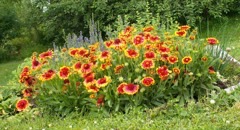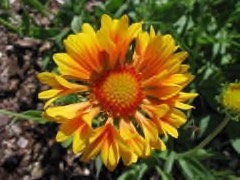 |
|
Gustaf Eriksson wikimedia.org |
 |
| Captain-tucker wikimedia.org |
Translate this page:
Summary
Physical Characteristics

 Gaillardia x grandiflora is a PERENNIAL growing to 0.3 m (1ft) by 0.5 m (1ft 8in) at a fast rate.
Gaillardia x grandiflora is a PERENNIAL growing to 0.3 m (1ft) by 0.5 m (1ft 8in) at a fast rate.
See above for USDA hardiness. It is hardy to UK zone 4. The flowers are pollinated by Butterflies birds.
It is noted for attracting wildlife.
Suitable for: light (sandy) and medium (loamy) soils, prefers well-drained soil and can grow in nutritionally poor soil. Suitable pH: mildly acid, neutral and basic (mildly alkaline) soils and can grow in very acid and very alkaline soils.
It cannot grow in the shade. It prefers dry or moist soil and can tolerate drought.
UK Hardiness Map
US Hardiness Map
Synonyms
No synonyms are recorded for this name.
Plant Habitats
Edible Uses
Edible Parts: Leaves
Edible Uses:
Leaf [2-1]. The species Gaillardia pinnatifida dried seeds can be ground into a powder then kneaded into seed butter and spread on bread[257] but no information was found for Gaillardia × grandiflora.
References More on Edible Uses
Medicinal Uses
Plants For A Future can not take any responsibility for any adverse effects from the use of plants. Always seek advice from a professional before using a plant medicinally.
The species Gaillardia pinnatifida is known as a diuretic, taken to give relief from painful urination[216, 257]. And an infusion of the leaves is taken internally, and a poultice applied externally, in the treatment of gout[257]. No information could be found on Gaillardia × grandiflora.
References More on Medicinal Uses
The Bookshop: Edible Plant Books
Our Latest books on Perennial Plants For Food Forests and Permaculture Gardens in paperback or digital formats.

Edible Tropical Plants
Food Forest Plants for Hotter Conditions: 250+ Plants For Tropical Food Forests & Permaculture Gardens.
More

Edible Temperate Plants
Plants for Your Food Forest: 500 Plants for Temperate Food Forests & Permaculture Gardens.
More

More Books
PFAF have eight books available in paperback and digital formats. Browse the shop for more information.
Shop Now
Other Uses
Containers Cut flowers
Ground cover for compact cultivars. Compact cultivars include G. x grandiflora “Arizona Sun” with stunning mahogany-red rimmed golden yellows (0.3m 12inches). G. x grandiflora “Mesa Peach” and “Mesa Red” (0.4m, 18 inches). Landscape uses include beds, borders, patios and containers. Locations include rock gardens, cottage garden, meadow, prairie, coastal, cutting garden and food forest. Sometimes grown as an annual. Attractive to butterflies and native bees. Insectory - excellent source of nectar for butterflies. Seeds provide food for birds. Good For Cut Flowers, Good For Containers, Extended Bloom Time (more than 4 weeks).
Special Uses
Attracts Wildlife Food Forest Ground Cover
References More on Other Uses
Cultivation details
A short-lived perennial winter hardy to USDA Zones 3 [368-1]. It prefers full sun, sandy, Loamy or Silty soil, and moderate to dry soil moisture. Soil pH: 5.5 - 7.9. Gaillardia × grandiflora is drought tolerant but prefers a moist well-drained soil. Performs poorly in unamended heavy clay soils [368-1]. Gaillardia × grandiflora is a tetraploid hybrid resulting from a cross between a 3’ tall perennial gaillardia (G. aristata) and a 2’ tall annual gaillardia (G. pulchella). It arguably inherited its perennial habit from the former and its long flowering period and rapid growth rate from the latter [368-1]. Flower Color: Orange, Red, Rust, or Yellow. Blooms late spring to fall. Heat zones 1 -8. Plants are so prolific and long blooming that they often exhaust themselves and are then short-lived[200]. Members of this genus are rarely if ever troubled by browsing deer[233]. Several cultivars exist, among them 'Arizona sun' and 'Arizona red shades'. Minimum Root Depth: 16 inches. In garden design, as well as the above-ground architecture of a plant, root structure considerations help in choosing plants that work together for their optimal soil requirements including nutrients and water. The root pattern is clumping, giving the plant a 'clumping' habit. The predictable growth behaviour makes it easier to maintain without having to apply containment methods[2-1].
References Carbon Farming Information and Carbon Sequestration Information
Temperature Converter
Type a value in the Celsius field to convert the value to Fahrenheit:
Fahrenheit:
The PFAF Bookshop
Plants For A Future have a number of books available in paperback and digital form. Book titles include Edible Plants, Edible Perennials, Edible Trees,Edible Shrubs, Woodland Gardening, and Temperate Food Forest Plants. Our new book is Food Forest Plants For Hotter Conditions (Tropical and Sub-Tropical).
Shop Now
Plant Propagation
Seed, basal cuttings, or division. Dividing them in spring or early fall every two to three years will improve vigor.
Other Names
If available other names are mentioned here
Gaillardia hybrid, Blanket flower, Arizona Sun Blanket Flower,
Native Range
Coming Soon
Weed Potential
Right plant wrong place. We are currently updating this section.
Please note that a plant may be invasive in one area but may not in your area so it's worth checking.
None Known
Conservation Status
IUCN Red List of Threatened Plants Status : Not Listed.

Growth: S = slow M = medium F = fast. Soil: L = light (sandy) M = medium H = heavy (clay). pH: A = acid N = neutral B = basic (alkaline). Shade: F = full shade S = semi-shade N = no shade. Moisture: D = dry M = Moist We = wet Wa = water.
Now available:
Food Forest Plants for Mediterranean Conditions
350+ Perennial Plants For Mediterranean and Drier Food Forests and Permaculture Gardens.
[Paperback and eBook]
This is the third in Plants For A Future's series of plant guides for food forests tailored to
specific climate zones. Following volumes on temperate and tropical ecosystems, this book focuses
on species suited to Mediterranean conditions—regions with hot, dry summers and cool, wet winters,
often facing the added challenge of climate change.
Read More
Expert comment
Author
Hort. ex Van Houtte
Botanical References
Links / References
For a list of references used on this page please go here
Readers comment
| Add a comment |
|
If you have important information about this plant that may help other users please add a comment or link below. Only comments or links that are felt to be directly relevant to a plant will be included. If you think a comment/link or information contained on this page is inaccurate or misleading we would welcome your feedback at [email protected]. If you have questions about a plant please use the Forum on this website as we do not have the resources to answer questions ourselves.
* Please note: the comments by website users are not necessarily those held by PFAF and may give misleading or inaccurate information.
To leave a comment please Register or login here All comments need to be approved so will not appear immediately.
|
Subject : Gaillardia x grandiflora
|
|
|
|